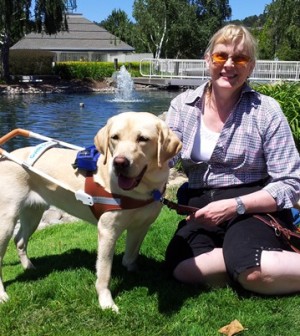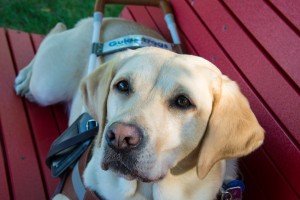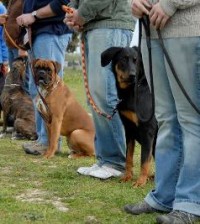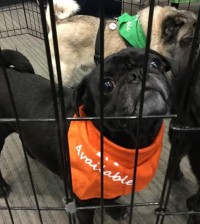- Do you subscribe to Dharma Dog Training’s Newsletter? You should.
- A Unique Campaign from The Humane Society of the United States
- Rabid bats in Omaha- Stay safe, prepared with these tips
- Springtime Activities in Omaha
- Mill Dog Monthly from Bailing Out Benji
- World Spay Day, Legislative Alert in Nebraska
- Attend the Nebraska Rescue Council’s monthly meeting this Saturday
- Five Hard-to-Ignore Reasons to Adopt!
- Paws in Pink to Benefit Breast Cancer Foundation
- VCA, Inc. Acquires MidWest Vet Specialists from Kansas State University
Meet Kay Konz and her service dog, Jonquil

Kay Konz’s story is probably much like many folks’ here in the Heartland. She’s a farmer’s daughter. She grew up in a sleepy rural town in Southwest Iowa. She attended the Catholic Elementary School and the parish had a bus that later took students to St. Albert High in Council Bluffs. After she got her bachelor’s degree in education and psychology with minors in special education and English at Dana College in Blair, she taught special education for 2 years.
Family, school, work. A gradual release into the world not unlike many, but like all of us, there is a special part of her story. Her gradual release also included a gradual deterioration in her vision as a result of retinus pigmentosa. Special sunglasses, service dogs, education and advocacy all became part of her identity and she now dedicates her work to helping others through awareness, therapy and interaction, especially with kids who experience developmental trauma.
Shortly after starting graduate school in school psychology at the University of Iowa, Konz’s older sister was referred to the ophthalmology clinic at the University of Iowa because her physician was concerned about her night vision. “I had tried to reassure her that it was not a major concern, and laughed about not being able to see well at night myself,” she says. She had first been prescribed glasses for amblyopia and hyperopia as a 19-month-old, but her sister had always had good vision. The diagnosis from the clinic was retinitis pigmentosa (RP), a genetic disorder bringing night blindness, a gradual loss in peripheral vision and eventual blindness.
By then, their mother had asked some questions and learned that two cousins of her father had been diagnosed with RP as adults, although they did not develop symptoms unit they were in their 40s. Konz and her sister were in their mid-twenties.
Because the disorder was genetic, and the ophthalmologist wanted to also evaluate anyone else in the family with symptoms, Kay made arrangements for the same physician to examine her eyes. “My reasoning was simple: We are good people. This disease causes blindness. We did not have this disease. SO, I will prove to them that they are wrong.”
That reaction is classic denial, as the psychologist in her acknowledges. “But I was a bright woman, and as the ophthalmologist confirmed the diagnosis of Retinitis Pigmentosa while handing me a tissue, he said ‘You already knew that, Kay.'”
Over the next 25 years, she and her sister made gradual concessions to the limitations of RP. She gave up driving at night, got special sunglasses to protect retinas and researched RP. Kay found the RP Foundation Fighting Blindness, attended conventions, helped organize a local chapter and served on the Board and as an officer. “I became a good public speaker, raised awareness, became familiar with research and made friends through my involvement with those around RP,” she says.
As she lost more peripheral vision, she restricted her driving to familiar roads and drove shorter distances. And even though she had initially been disgusted by the possibility of being led around by a dog, she noticed the friends she had made who lived with PR used guide dogs and were more independent. She began to investigate the service dog school near Lincoln.
By 2006, Kay had become familiar with the bus system and was driving her car only a few blocks to the grocery store, church and the like. She hadn’t gotten gas in her car for months and went to get my driver’s license one day, discovering she was already legally blind. She failed her vision test on her 49th birthday, walked out of the DMV with only a state ID and burst into tears.
There is no cure or treatment for RP. Corrective lenses are prescribed for problems with the surface or curvature of the eye. Corneal transplants replace a cornea, but Retinitis pigmentosa affects the retina, the filmy tissue a back of the eye that is connected to the brain. Her vision is such that “it is like looking through binoculars backwards.” With her vision continuing to deteriorate while she still wished to be as independent as possible, Kay got a service dog.
Her first guide dog and she were matched in 2008. Han Solo (Hans) was trained through Noah’s Assistance Dogs in Crete. He was named by the woman who had bred his mother and father, and some of his siblings became police dogs. “Hans didn’t have a personality to enjoy being a police dog. He never tried to be the alpha dog,” she says. Hans had to be retired after about 4 years ago when Kay discovered that he had severe elbow dysplasia and arthritis in his hips. “That was a very difficult period for me,” she says. “To say goodbye to the John who gave me a foundation and the John who gave me my independence.” Her father, John (the English name for the German “Hans”) had passed away about the time her pup Hans retired.
It was a year before Kay was able to get her next dog. In the period between, she used a cane. She still uses one occasionally when she’s without her guide dog. “I was disappointed at the reaction of others when I have to use a cane,” she says. “I have noticed that associates in stores walk away when they see a me, or they speak to the person I’m with rather than me. Most people are willing to help me when I’m with a dog. The challenge then becomes putting parameters on their interaction with my dog, so that she can remain focused.” Kay is an expert in guide dog etiquette.
Jonquil and Kay became partners in the spring of 2013. Jonquil is about half the size of Hans and is a yellow Lab. She is the color of butter with shorter legs and a shorter nose. “I admit that I was worried I would not be happy with a dog that wasn’t a German shepherd and knew the school she was from raised only Labs, but I fell in love with her the moment we met.” Jonquil loves people and is mostly calm, but less adventurous than Hans. She is more confident, but just as sensitive to Kay’s mood. Jonquil is also more affectionate. “She has slept on my bed since the first days we got home,” she says. Hans always slept beside her bed, rarely cuddling next to her as Jonquil does.
“She is a little possessive and wanted nothing to do with anything that smelled like Hans,” she says. Jonquil is also “a princess” and doesn’t like getting her feet wet.
Guide Dogs for the Blind, the school Jonquil came from, raises about 1500 dogs a year across two campuses. About 600 become guide dogs. Some dogs have health or other problems that are not compatible with guide dog work. Some have personalities that don’t fit with being a service dogs, and some do not respond well to training. Jonquil graduated and has worked with Kay since last year. Her former trainers were married and Jonquil sent them yellow roses as a congratulatory gift. Kay may or may not have helped…
Jonquil was with a guide dog raiser for six to eight months and received additional training to keep her in shape after the first placement plan was cancelled (Jonquil developed kennel cough). She was taught to stop at curbs and curb cuts and to disobey if Kay gives a command to go forward if there is traffic. She is trained to stop at barriers and take Kay around them. She leads Kay to one side of a sidewalk if there is a crowd or other obstruction next to a building. Jonquil is also trained to stop at the top of stairs or steps and let Kay find a handrail if available. She cannot gauge the depths of steps- that’s up to Kay, which is often difficult. She ignores other dogs and cats and people talking to her although Kay admits she has gotten “a little lax” about that. Jonquil knows when people are talking to her or about her and often looks to Kay for permission to greet them. “Others are surprised if they give her a command and she doesn’t follow it, but she is never supposed to follow commands except from me,” Kay says, “as it would be dangerous for her to respond to commands from others.” Her personality changes when she is in her harness and working. She’s all business then and Kay has tried to get her to smile in harness to no avail. “She is that serious about her work,” Kay says. When not in harness, she’s an active, playful three-year-old.
Kay is a Licensed Independent Mental Health Practitioner and Jonquil accompanies her to work each day. She guides her around the cracks in the driveway. She helps Kay onto the transit van then into her office building, traveling around any impediments in their path. “I often take her out of harness at the office to greet people who work with me.” She spends time in Kay’s office either on the loveseat or on a pillow under a desk. If a client becomes upset and tearful, she gets up and tries to comfort. She usually waits for Kay to tell her that she can greet a client who enters, but reminds Kay if she doesn’t remember. “If a child client seems to be a bit impulsive or out of control, she gets out of the way and goes under my desk,” Kay says. Jonquil is a very astute observer and has an amazing level of empathy for a pup.
Jonquil has been a trooper the last few months as Kay has not always been able to work her. Kay broke her right heel recently and has had to use a wheelchair or knee scooter rather than her guide dog. “I feel obligated to explain to people that it was not Jonquil’s error that I suffered a fall. We were looking for the handicapped entrance to an unfamiliar building and it made sense to walk down the sidewalk near the handicapped parking space sign which had no steps. Then we turned into a parking lot and followed the side of the building until we encountered a rounded curb around a grassy area with a tree that appeared to be attached to a sidewalk next to the building. Jonquil found an up-curb, but it was the top of a retaining wall for a ramp entrance to the office. It was such a bad design that Jonquil could not see that it was not a sidewalk.” The two dropped about 2 feet. “She was upset for a minute but then settled down and was very calm as we waited for an ambulance and in the ER and X-ray, and then learned how to heel to the wheelchair and scooter, keeping her toes away from the wheels. We were actually very near the handicapped entrance of the place we started and there had been a sign pointing in that direction that our driver had not noticed. So in spite of the benefits of having a dog, which has a brain, as compared to a cane, and in spite of the environments mandated by the American with Disabilities Act, we still encounter hazards.”
Some people have very high expectations of a service dog, and expect them to be able to do his or her job while still interacting. Most humans can’t do this. “I wish that others would avoid eye contact with her when she is working,” Kay says, “but I know that is difficult to do as she is so pretty. I had joked that I wanted an ugly guide dog so we would not get so much attention, but I seem to get the most beautiful dogs.”
Kay explains to all of her young clients that the dog’s harness is a visual signal, that they should never interact with the dog when she is in harness. “I am often surprised at how much people don’t know about service dogs,” Kay says. Kay remembers reading a book about a guide dog when she was a child and suspected that others knew of etiquette as she does, but that’s just not the case. “I have tried writing a book for children and adults to address that, but I have not had a lot of time to work on it. It is still such a shock to me of how much time everyday tasks can take when blind, so time is my most precious resource.”
In general, Kay has found that children are more comfortable and accepting of her blindness than adults. They are generally less anxious about it and more able to provide assistance when requested. Adults often try to be helpful, but without knowing what is needed, it’s hard for them.
It seems that we will all need to be more attentive to the needs of persons with low vision in the coming decades. This year, the first wave of the Baby Boom generation turns 68. The most common cause of age-related blindness is macular degeneration, which is like the inverse of RP. In macular degeneration the central vision deteriorates and peripheral vision remains. There are some treatments for AMD but no cure, although organizations like Hope for Vision, for whom Kay is a volunteer, and The Foundation for Fighting Blindness, raise money for research to find treatments. Kay is concerned about places like where she fell. As it was still meeting code it could have caused a much worse injury. The need for research funds will surely become more urgent.
Places like the University of Nebraska Medical Center has a lab that is working to identify sites in the eye where stem cells can be found and coaxed into growing into retinal cells for transplantation but is still using animal modes. Genetics researchers are working to develop a method to correct the information being communicated among cells, but this work is not yet ready for human trial. We are much closer to a treatment than we were thirty years ago when Kay and her sister were diagnosed, but we are not as close as we thought we were then.
For more information about Kay and her work, visit www.kaykonz.com. Also, check back with Pets in Omaha soon for information about guide dog etiquette from Kay and others to inform readers and make life easier for people like Kay and guide dogs like Jonquil.
Related Posts
Latest News
-
Join Us at Pick A Pooch 2025: A Fun-Filled Weekend for the Whole Family
A Fun-Filled Weekend for Pet Lovers and Families Alike Mark...
- Posted 1 year ago
- 0
-
Beardmore Presenting Sponsor At This Years Pick-A-Pooch event
🐾 We are thrilled to announce that Beardmore Subaru is...
- Posted 1 month ago
- 0
-
How Having A Pet Can Change Your Life
Having a pet can open your heart in ways that...
- Posted 3 months ago
- 0
-
How To Improve The Life Of Your Senior Pet
Do you have an elderly fur baby and want to...
- Posted 3 months ago
- 0
-
Springtime Activities To Enjoy With Your Furry Friends
Are you preparing for warmer weather and want some ideas...
- Posted 4 months ago
- 0
-
Pros And Cons Of Microchipping Your Pets
Have you considered whether your pets should be microchipped and...
- Posted 5 months ago
- 0
-
The Best New Fun Toys For Dogs And Cats
The Best New Fun Toys For Dogs And Cats Did...
- Posted 5 months ago
- 0
-
Heartfelt Ways To Show Your Pet You Love Them
Did you know there are more ways to show your...
- Posted 6 months ago
- 0
























You must be logged in to post a comment Login